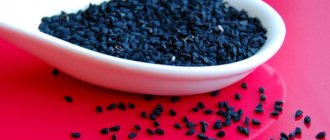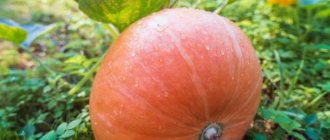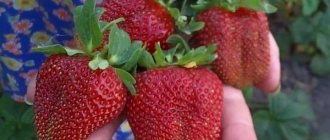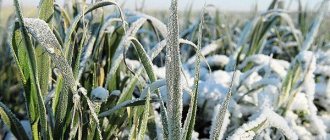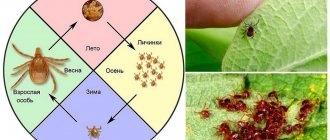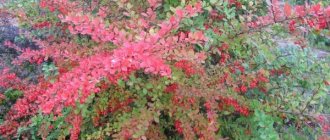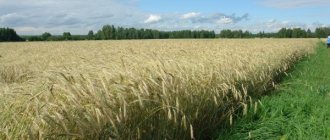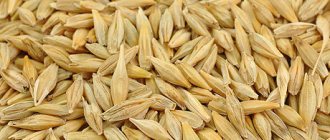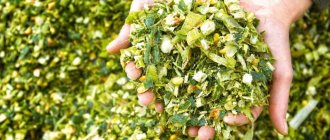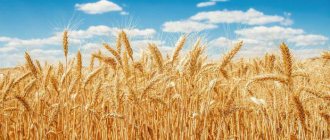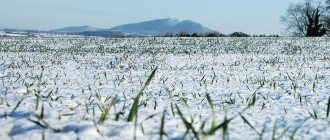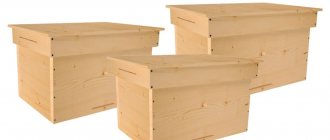In former times, ryeRye is an annual (biennial) herbaceous plant of the Evil family... was the main grain crop of Europe. Today, its role has been taken by wheat, while rye. Cultivated rye is an annual (biennial) herbaceous plant of the Evil family... is content with third place in terms of grain harvest volume, second even to barley. However, given its high endurance and adaptability to cold climates, it remains a fairly important agricultural plant for Russia.
Description of spring rye
Spring rye is one of the forms of seed rye. Unlike the winter form, which is sown in the fall before winter, spring rye is sown in the spring. The word “yarovaya” comes from the name Yarila, the god associated with the sun and the awakening of nature. Spring rye is harvested in late summer or early autumn.
Rye is an aggressive plant that can suppress any weed. Only cornflowers grow in rye fields. Advantages of rye of any form - spring or winter, compared to wheat:
- more resilient and unpretentious;
- higher resistance to diseases and pests;
- high resistance to lodging;
- is an effective green manure - improves the structure and condition of the soil;
- active phytosanitary – suppresses weeds.
Botanical description of spring rye:
- Root system. The fibrous roots penetrate 1-2 m deep. It grows on difficult soils. High digestibility of nutrients. The plant is characterized by intensive tillering. About a dozen shoots grow from one grain, and with good care - 5-10 times more.
- Stem. It is a hollow tube with several internodes - from 3 to 7. The stem is pubescent, straight, pubescence is present only directly under the ear. The average height of the stem is 0.8-1 m.
- Leaves. The length of the flat leaf is 15-30 cm. The leaves are narrow – no more than 2.5 cm in width. The leaf blade at the top is pubescent - this is an indicator of resistance to moisture deficiency.
- Inflorescence. The ear is elongated, unbreakable, with a strong axis. The length of the spike is 5-15 cm, the width is 0.8-1.2 cm. The awns of the spike are rough, the length is 3-5 cm. The anthers of flowers with three stamens protrude from the spikelet. Flowers are pollinated by wind.
- Corn. The shape is elongated, oblong, with a longitudinal groove in the center. The embryo is clearly visible. The surface of the grain is slightly wrinkled. Rye grain size: length – 4-10 mm, width – 1.5-3.5 mm. The weight of 1000 grains is 12-45 g. The grain of spring rye is smaller than that of winter rye. Rye grain is similar in chemical composition to wheat grain, but there are also differences. Rye grain contains less protein than wheat grain, but has more globulins and albumins. It also has less gluten and is of lower quality than wheat. The grain is yellow, gray-green, brown and reddish in color.
Rye cultivation technology
The conditions for growing rye should be aimed at obtaining a high yield. In order for rye to grow well, you need to maintain proper crop rotation. It includes the selection of high-quality seeds, soil cultivation, compliance with sowing dates, plant care, disease control and fertilization. Intensive cultivation technology also includes measures to preserve moisture in the soil.
To obtain a high yield at lower physical costs, winter and spring rye are sown after the predecessor plants. For winter varieties this is:
- Lupine and clover;
- Corn, peas and beans;
- Buckwheat;
- Early potato varieties;
- Spring wheat.
The best precursors are pure pairs. Spring varieties are less demanding of their predecessors. They grow well after perennial grasses, winter rye, rapeseed, clover and corn.
When planting seeds, take into account the seeding rate developed for the given region. For the Urals and Siberia this is 6.3 million per hectare, for non-chernozem regions - 6.5 million per hectare, for chernozem regions - 5.5 million per hectare.
Planting rye
Sowing consists of three stages:
- Seed preparation;
- Soil preparation;
- Sowing work.
For sowing, it is recommended to select only seed material. Feed and food grains do not provide good germination. For seeds of winter varieties, GOST defines the following indicators:
- Germination rate - from 92%;
- Purity - from 99%;
- Humidity - no more than 14%;
- Weight of 1000 seeds - not less than 35g;
- Growth power - over 80%.
Before sowing, grains are treated against rust, root rot, smut and stem smut. For this purpose drugs are used:
- Teagam;
- Vitatiuram;
- Fungicide;
- Hexatiuram.
If freshly harvested seeds are planted, they must be heated in the sun for 3-5 days or using a special grain dryer at a temperature of 45°C. Warm-up time: 3-4 hours. The process of preparing seed material includes several stages:
- Preliminary cleaning from coarse organic and mineral impurities;
- Drying;
- Cleaning from weeds and their seeds;
- Cleaning from grain impurities;
- Air-heat treatment (2-3 weeks before planting);
- Treating (10-16 days before planting).
To improve germination, seeds can be additionally treated with growth regulators and nutrients.
Soil preparation
After harvesting the predecessor, the fields are peeled to a depth of 8 cm. When harvesting the crop late or in cold weather, peeling is not necessary: it is replaced by applying manure and plowing to a depth of 30-35 cm. If the grain is planted after perennial grasses, then the soil is first disced and then plow with skimmers. After harvesting legume-oat mixtures and when the soil is wet, the soil is plowed to its full depth.
After the snow has melted and the soil has dried, harrowing and cultivation are carried out twice. If the field is heavily weeded, one cultivation is replaced by the application of a herbicide.
For spring rye, the soil is prepared in the fall:
- After the vegetable predecessors, the main soil cultivation is carried out to a depth of 17 cm or with disc harrows to a depth of 13 cm;
- After one-year injuries and buckwheat, peeling is carried out. If the field is heavily weeded, cultivation and disking are required.
- Plowing of plowed land is carried out in the second half of August to reduce the level of weeds, accumulate moisture and preserve nutrients. In crop fields with a large number of stones, plowing is carried out with plows with protection of working parts, and for smooth plowing, reversible types of plows are used.
In early spring, the soil is cultivated according to the physical ripeness of the soil. Depending on the granulometric composition of the soil, it is first harrowed, and heavier types of soil require cultivation without the use of a harrow and to a depth of 6 cm.
Sowing methods
To plant seeds, 3 sowing methods are used:
- Narrow row, with a width between beds of about 8 cm;
- Solid;
- Cross.
For continuous and cross sowing, the distance between the ridges is 14-17 cm. The sowing depth depends on the crop variety and soil type. For spring varieties this is usually 3-5 cm. Winter rye is more demanding on planting depth, since its tillering nodes are formed near the surface.
Seeds are planted on moist soil:
- On heavy soil - 2-3 cm;
- At medium density - by 3-5 cm;
- On light - 5-6 cm.
In dry weather and dry soil, the planting depth is increased by 1-2 cm to avoid blowing out the seed. If the arable soil is not sufficiently moistened after sowing, then rolling is carried out. This allows the seeds to strengthen in the ground and raises moisture to the upper layers.
Sowing time
Sowing time depends on the region and weather conditions:
- In the southern regions, winter crops are planted from the 4th week of September until mid-October;
- In Siberia - from the first ten days of August to mid-September;
- In non-chernozem regions - from August 5 to August 30;
- In the southeastern regions - from August 15 to September 5.
When calculating planting dates, it is assumed that the autumn growth period lasts about 45 days. The volume of average daily temperatures in this period should be equal to 445-555°C.
Planting of spring rye begins when the soil is actually physically ready, when the top layer warms up to +2°C. The seeds survive frosts well down to -8°C. In the northern regions, rye usually begins to be sown in the second half of May, in the southern regions - at the end of April and at the beginning of May. In Siberia - in mid-May.
Demand for sowing
Typically, spring rye is used as a replacement for winter rye that has been damaged or died for some reason. The low demand for spring rye can be explained simply - it is weaker than its winter counterpart, less productive and not as resistant to environmental challenges.
There are 10 species in the rye genus, but only one species is cultivated - rye. All others are wild. Seed rye has 39 varieties, but in the Russian Federation only common rye is grown. Spring rye in Russia accounts for about 1% of all sown areas.
Rye - description of the plant
Cultivated rye (rye) is a herbaceous plant that can be either annual or biennial. It is cultivated rye that is widespread and grown all over the world, but most of all in the northern hemisphere.
Nowadays, it has become customary that the word “rye” means precisely the seed crop. Although, in addition to it, there are several other types of rye:
- African rye;
- forest rye;
- mountain rye;
- Vavilov's rye;
- Derzhavin's rye;
- Anatolian, etc.
In Russia, for example, you can find forest rye, which grows as wild grass.
Terrain and climate for growing rye
It is profitable to grow winter rye, as it is a frost-resistant plant that gives a good harvest. It can easily withstand winter temperatures down to minus 35°C. But if the climate in winter is very harsh, then winter rye will not withstand it. Therefore, spring crops are in demand where extremely severe frosts are observed in winter, preventing winter crops from surviving. That is why in the Far North they sow spring rye in the spring and completely abandon winter rye.
Spring rye is grown in regions with risky agriculture - in Transbaikalia, Central Siberia, and Yakutia (Republic of Sakha). The regions where the bulk of fields of spring rye are located, sown purposefully, and not for reseeding winter crops, are Buryatia and the Chita region.
Origin and distribution of the plant
There is still no single coherent version about the origin and cultivation of rye, only a lot of assumptions and hypotheses. Thanks to archaeologists and the artifacts found (writings, frescoes, fossils), it is known for certain that the ancient Egyptians, the peoples of Asia and India knew and cultivated culture already in the 4th century. BC.
Most scientists agree that the cereal originated on the territory of modern Iran and Turkey. The plant was eradicated as a weed that infests wheat and barley crops.
You may be interested in information about how buckwheat grows.
Over time, farmers noted the plant's resistance to cold and its ability to grow on poor soils and in mountainous areas. Since the crop grew practically unattended, did not require special participation of ancient farmers and survived where wheat and barley died en masse, it began to be cultivated. Due to its resistance to external factors, the cost of the harvest was low. All segments of the population could afford products made from rye grains, unlike wheat products.
Today, rye is grown in large quantities throughout almost the entire Northern Hemisphere, namely:
- North America;
- Canada;
- Scandinavian countries;
- Europe and Baltic countries;
- Russia;
- China.
Pay attention to the information on the use of buckwheat as green manure.
What varieties are there?
Spring rye is in little demand in agriculture, which is why there are few varieties:
- Vyatka. An experimental variety developed specifically for the Volga-Vyatka region. Used for reseeding if winter rye dies. Refers to mid-season varieties. The average growing season is 100 days. The variety tolerates low temperatures well, germinates quickly, bushes quickly and forms tubes. If ripening occurs in rainy weather, the ears are often hollow or through the grain. If conditions are favorable, the yield is 40 c/ha. The variety is resistant to lodging, disease damage does not exceed the level of the winter form.
- Onokhoyskaya. A variety developed by Buryat breeders. Designed for the harsh conditions of Eastern Siberia. The plant is tall - it grows up to 2.5-3 m. There is a tendency to lodging. The leaves are narrow, bushiness is moderate. The ear is prismatic, large, the grain is large. The growing season is 130-140 days. If you sow the seeds in May, then at the end of September you can already harvest. The grain is elongated, shedding is insignificant. Color – gray-green, with yellow. 1000 grains weigh 24-30 g. Tolerates spring drought and frost. It is distinguished by its friendly shoots and rapid growth at the beginning of the growing season. Effectively suppresses weeds.
- Svitanok. Ukrainian variety bred on the basis of the Leningradskaya variety. It is a safety crop and is used for reseeding winter crops. The growing season is 120-130 days. The bush is erect, with a strong stem and light green leaves. Spike length – 8-10 cm. Plant height – 1.2-1.6 m. Large grain, weight of 1000 pieces – 40 g. High resistance to root rot, powdery mildew and snow mold. Disadvantage: lodging. The peculiarity of the variety is high yields on soils poor in nitrogen.
The benefits of green organics
Green manures are natural organic fertilizers that provide natural nutrition and exchange of nutrients in the soil. Their main advantage is safety for the environment, which is why such plants are often grown in summer cottages. It has been proven that natural fertilizers can increase soil fertility in the garden several times. In addition, they contribute to the accumulation of nutrients in the soil, thereby providing nutrition and support to plants throughout the entire period of development.
Seed preparation
In order for the shoots to be friendly and the harvest to be decent, grain is sown in soil treated according to agricultural technology and the seeds are properly prepared for sowing. Only well-developed grains are taken. To determine this indicator, seeds are tested for germination in laboratory conditions.
Minimum seed quality indicators:
- germination – from 93-95%;
- purity – 98.5%.
The permissible norm of weed seeds is 20 g per 1 kg of rye grains. Before sowing the seeds in the ground, they are dried under a canopy. The drying area should have good ventilation and direct sunlight on the grain. Drying time – 3-4 days. To dry the grain faster, they use drying chambers - here it is heated to 60°C, and the drying process lasts only 2.5 hours.
After drying, the grains must be pickled to prevent diseases and stimulate shoot growth. Grain from last year's harvest is used as seeds.
Chemical composition and beneficial properties
Rye has a rich chemical composition and low calorie content, which makes it a valuable dietary product. Content of useful elements (in% of daily value):
| Vitamins | Minerals | Acids | Other substances |
| thiamine, B1 - 29.3 | potassium - 17 | Omega-3 - 14.4 | carbohydrates (pectin, fiber, sucrose)—20.8 |
| riboflavin, B2 - 11.1 | silicon - 283.3 | Omega-6 - 18.3 | phytosterols - 190.5 |
| pantothenic acid, B5 - 20 | magnesium - 30 | essential (valine, phenylalaline, isoleucine, threonine) - 17 | |
| pyridoxine, B6 - 20.5 | phosphorus - 45.8 | replaceable (glutamic, proline) - 13.8 | Text 20 |
| folates, B9 - 13.8 | iron - 30 | Text 24 | |
| tocopherol, E - 18.7 | cobalt -76 | ||
| biotin, N - 12 | manganese - 138.5 | ||
| niacin, PP - 17.5 | copper - 46 | ||
| molybdenum - 25.7 |
Considering the rich content of useful elements, rye is certainly healthy and should be present in the diet. Nutritionists recommend eating rye bread for people with increased body weight, since it is low in calories compared to wheat products. In addition, the product helps remove toxins and bad cholesterol from the body, which also promotes weight loss.
- Other useful properties:
- improvement of digestion processes;
- decreased acidity of gastric juice;
- assistance in the functioning of the enzymatic system;
- normalization of blood glucose levels;
- supporting the work of the heart muscle;
- strengthening blood vessels;
- improving the functioning of the hormonal and reproductive systems;
- strengthening the immune system.
Soil preparation
Soil preparation for spring rye includes:
- Autumn processing. In September-October, steam is prepared, the soil is plowed and processed with a flat cutter. Loosening depth – 26-30 cm.
- Spring processing. Harrow the soil to a depth of 5 cm. The task of harrowing is to break up the soil crust, destroy shoots, mold, weed seeds and the remains of dead plants. Thanks to harrowing during spring sowing, the yield of spring rye increases by 15-20%.
Nitrogen fertilizers are applied during pre-sowing tillage, and phosphorus fertilizers are applied during sowing.
Rye: care rules (weed control, pest control, soil cultivation, fertilizing)
By and large, caring for a rye bed, compared to a wheat bed, is much simpler and cheaper. The explanation for this is the plant’s tolerance to parasites and pathogens. Before growing rye, let's get acquainted with its main requirements, roughly dividing them by season.
In autumn, it is important to create conditions for good germination, rooting, tillering and flooding of cereals. For this purpose, the sown area is rolled in dry weather, with the exception of crops on heavy soils. Otherwise, you risk greatly compacting the grains and soil, resulting in a tight crust, which will make it difficult for the sprouts to hatch.
For the winter, it is advisable to fertilize the bed with a phosphorus-potassium mixture, which will strengthen and promote the hardening of the rye.
Nitrogen-containing fertilizers are not yet recommended for young shoots - they will destroy the cold-resistant qualities of the variety.
In winter, you need to help the cereal grass overcome the cold, the formed ice crust and other obstacles to growth. Snow retention will help save the crop and increase its yield. On large farms it is carried out using forest belts, but at home you can limit yourself to arranging brushwood or shields.
From the end of November until March, vigilant owners germinate samples to apply competent measures for further care.
In spring, you need to make sure that water does not accumulate on the field. If it stands for more than 10 days on sowing, everything will be lost. On sandy soil, which constantly suffers from a lack of moisture, there is a need to retain melt streams. And in conditions of a sharp premature thaw, roll the field with a roller to retain the snow cover on it. The procedure will help the rye to safely survive subsequent frosts. Do not compact the entire area; leave row spacing.
With the onset of warmth, a few days after the earthen ball stops sticking together, carry out harrowing to destroy the top crust and remove emerging weeds. Rye aggressively displaces other plants from the site, so herbicides are applied rarely, in heavily weeded areas.
Soon you will need to feed the sprouts that survived the winter. Agronomists recommend applying mineral fertilizers twice: before the main tillage and in the spring. The norms are calculated at a level lower than that of winter wheat, since large dosages provoke lodging of the stems. In addition, rye absorbs nutrients much more intensively even from inaccessible depths of the soil. On average, from 45 to 90 kg of nitrogen, phosphorus and potassium are used per hectare.
Corrections are made by soil characteristics. The rate is increased when the predecessors were stubble crops, and when growing tetraploid rye species. But after corn it is worth increasing the amount of nitrogen, and, on the contrary, reducing it after peas and perennial herbal plants.
The full dose of potassium fertilizers, 80% of phosphorus fertilizers are applied when cultivating the soil, the remaining 20–15% of phosphorus is applied during sowing. As an alternative, heavily decomposed phosphate rock mixed with manure and peat is considered. On poor substrates, it is appropriate to fertilize with nitrogen (30 kg/ha) when forming a bed.
To feed green mass, 30–60 kg/ha of nitrogen is added at the third stage of organogenesis, and 30 kg/ha at the fourth stage. In an acidic environment, when the pH is less than 5, winter crops lack lime (3 – 5 t/ha), and on salt marshes – gypsum (3 – 5 t/ha).
Of the organic fertilizers for rye, manure, compost mixtures of peat and manure, phosphate rock and lime are important.
In summer there is no longer any need to till the soil, however, care does not stop. Now comes the time to combat pests, diseases and preventive measures. Despite the resistance of rye, due to some climatic circumstances, cases of fall armyworm infection of winter crops cannot be ruled out. Its caterpillars die under the influence of insecticides. The plant is loved by weevils, bread beetles, bugs, turuns, and cross grass. They greatly spoil the stems and grain. Inspect your garden periodically and treat it in calm weather with special products. Pests will disappear from the soil if winter rye and straw are harvested in a timely manner and the soil is properly prepared. A sevo change would be appropriate.
Don't forget to pull out any rare weeds. To prevent lodging of the stems, in the booting phase they are sprayed with Campazon 50% (3 - 4 l/ha) or a mixture of Campazon (1.5 - 2 l/ha) and TUR (3 l/ha). By the way, the latter drug can be mixed with herbicides if there is a need to add them.
Optimal sowing dates
Spring rye seeds are sown in spring. Sowing occurs in the second half of May. More precise timing and depth of seed placement depend on climatic conditions:
- In the forest-steppe zone, sowing begins in the third week of May.
- In the steppe zone - in the fourth week of May.
- In the Far East - May 1-20.
- In Siberia – May 10-20.
The timing of sowing also depends on the early maturity of the variety. So, for example, in Eastern Siberian farms:
- early rye is sown on May 15-25;
- mid-season - May 5-15.
If the soil has warmed up and there is no promise of frost, sowing begins earlier.
How to properly harvest rye
Rye is ripe when the grain holds well in the ear and does not crumble, but dry substances no longer flow into it. Harvesting of the grain mass begins in the middle of waxy ripeness, avoiding loss of seeds and lodging of ears. This process is first carried out using rollers with an optimal thickness of 20 cm, 15 cm when there is excess moisture in the air, and 25 cm when there is drought. At the same time, the combine does not change direction; the ears are fed into the header. In terms of harvesting time, winter rye ripens faster than wheat by 7–8 days. The resulting grain first undergoes cleaning, sorting, and then goes to drying and storage.
In the garden, the stubble is peeled and the soil is plowed to a depth of 20 cm. In the future, cultivation using half-steam technology and three-time cultivation will not hurt. The measures taken will protect future crops from parasites and fungi.
Care and cultivation
Spring grain crops, including rye, quickly absorb nutrients. Yaritsa, having a shorter growing season than winter rye, consumes no less nutrients. Tillering in spring rye is less intense, and the root system is weaker than in winter crops - it is important to provide it with adequate nutrition, as well as protection from diseases and pests.
Feeding and processing
Fertilizer requirements of spring crops:
- Nitrogen. The greatest need for nitrogen fertilizers is observed at the beginning of tillering. During the time from tillering to emergence, the plant absorbs 40% of the total nitrogen consumed during the growing season. To obtain 1 ton of grain, about 30 kg of nitrogen fertilizers are needed. Nitrogen fertilizers are applied in three stages - in the spring during cultivation, at the single node stage and at the heading stage.
- Phosphorus. Spring plants require the most phosphorus during rapid growth. Phosphorus helps to form a strong root system, promotes the formation of a large ear and early ripening. Phosphorus does not provide such an increase in yield as nitrogen fertilizers, but without it plants develop poorly. To obtain 1 ton of grain, 11.5 kg of phosphorus is required. Phosphorus fertilizers are applied in the fall during fall plowing or in the spring during pre-sowing cultivation.
- Potassium. Spring crops need potassium most during the first growth period. To obtain 1 ton of grain, 25 kg of potassium is required. Potassium fertilizers are applied in the same way as phosphorus fertilizers - in autumn or spring.
Spring rye finishes absorbing nutrients when it approaches the heading and flowering period. The exact doses of mineral fertilizers for cultivating spring rye are calculated taking into account specific conditions. What matters is the type of soil, its composition, predecessor, and planned yield.
An important task of caring for rye crops is to prevent the appearance of weeds. Soil cultivation includes the following activities:
- Harrowing. Apply when seedlings reach the 2-3 leaf stage. If you are late with harrowing and the weeds become stronger and form true leaves, the effect of this agrotechnical measure will be small. In practice, harrowing to kill weeds is used extremely rarely.
- Herbicide treatment. The type and dose are selected depending on the types of weeds. Spring rye grows quickly, it effectively suppresses weeds, and there is not always a need to use poisons. If herbicides are still applied, this is done during the tillering phase. If you start processing earlier, there is a risk of damage to cultivated plants. Delay causes deformation of the ear and a decrease in yield.
Herbicides are used in the form of aqueous solutions. Processing time – early morning or late evening, at a temperature of no more than 20°C. Ground spraying is used.
An effective technique for growing spring crops is foliar fertilization with copper. If the soil has a pH level of more than 6.0, the crops are fed with manganese. Feeding time is at the stage of 1-2 knots. Dosage – 50 g copper/manganese per 1 ha.
Diseases, pests and prevention
Protection and prevention of plants from diseases and pests is the key to a high yield. Common rye diseases and measures to combat them are in Table 1.
Table 1
| Disease | Symptoms | Control and prevention measures |
| Stem smut | Stripes on the stem, leaves, ear. They are leaden at first, then germinate with black spores. |
|
| Cercosporella basal rot | Spots appear at the bottom. The plant in the affected areas breaks and lies down. The grains are underdeveloped. |
|
| Fusarium root rot | Tillering nodes and internodes of rye become brown, sometimes with a pink coating. The trunk tissues are destroyed and the plant dies. |
|
| Powdery mildew | The leaves and stems are covered with a white coating, followed by black dots. The plant dies. |
|
| Yellow rust | The leaf blades are covered with lemon spots. The causative agent is a fungus. |
|
| Rhynchosporiasis | The appearance of red-brown stripes on the leaves. |
|
Spring rye, like any cereal crop, needs protection from pests.
Without protective measures, crop losses reach 15%. The most dangerous pests and protective measures are in Table 2.
table 2
| Pest | Protection measures |
| Striped leafhopper | insecticides during the period of heading and milky ripeness of grain |
| Cereal aphid | control of wild cereals and the use of insecticides in May-June |
| The turtle is harmful | selection of resistant varieties and treatment of larvae with insecticides |
| Wheat thrips | early fall plowing, pre-sowing cultivation, compliance with crop rotation, and, if necessary, chemical treatment |
| Ground beetle | compliance with crop rotation, separate harvesting with quick windrow threshing |
| Striped bread flea | prompt sowing of spring cereals and treatment of crops with insecticides during the emergence of beetles from wintering |
| Gray cutworm | peeling and early plowing of plowed land, treatment of row spacing |
Winter rye processing
Winter rye is processed to produce flour. Depending on the processing technology, there are several types of flour:
- The sifted flour is white with a slight grayish tint. It is soft, finely ground and widely used in bakery enterprises.
- Peel flour has many more large particles and shells and is characterized by a gray-white color.
- Wallpaper flour is coarsely ground. It is gray and is as close as possible to seeds in composition.
Dough made from rye flour gradually darkens, which is why the bread differs significantly from wheat in color.
Harvesting
When harvesting rye, the crop’s tendency to overripe and shed is taken into account, so it is important to start the harvesting campaign in a timely manner. The main thing in harvesting rye is to start on time. If you delay harvesting by at least 10 days, significant crop losses are inevitable. On the other hand, work started too early leads to a shortage of harvest, since some of the grain is unripe.
It takes 10-20 days from the milky-waxy ripeness of the grain to its full ripening. When harvesting grain with a combine, the best option is to achieve full ripeness of the grain. The moisture content of grains to be used as seed material should not exceed 20%.
When choosing a harvest time, it is important to consider the maturity of the straw. If its humidity is high and the stems are long, the harvester is adjusted to these conditions. Wet and long straw wraps around the drum, making threshing difficult. If the crops are not dead and the weather is favorable, harvesting begins even if the grain is not ripe.
Immediately after threshing, the grain is sent to the grain cleaning complex - for drying and sorting. The grain is brought to marketable condition. After threshing, the straw is removed from the fields to prepare the soil for the future harvest.
Despite the low prevalence of spring rye, this crop occupies an important place in agricultural production. Spring rye varieties make it possible to grow bread in risky farming areas and insure the crop when winter rye freezes.
0
0
Copy link
Application of culture
Cereal grains are ground into flour, from which bread and dietary buns are baked. Nowadays, rye baked goods are considered healthy and lower in calories than those made from wheat flour. In ancient times it was the food of the poor and was considered coarse and heavy.
Did you know? Pliny the Elder, a statesman of Ancient Rome (1st century BC), said that you can only eat rye bread when you are extremely hungry. And in the countries of the Ancient East, the plant was even considered a weed; in Persian, its name is “jou-dar” - one that clogs crops.
Bread kvass is one of the most popular drinks among the Slavs, and made from black bread it is also healthy and has less calories. In addition to baking flour, they produce starch, which is not inferior in quality to its potato counterpart. Alcohol is obtained from grain for the production of strong alcohol or for medical use. Rye beer is popular in Germany and Western Europe.
The cereal crop is used to make feed for livestock. Poultry are given sprouted seeds. The plant is an excellent green manure, which improves the soil structure and suppresses weeds. In the past, straw was used for roofing in homes; in some villages it is still used in the construction of outbuildings. The material is cheap, accessible and quite durable.
Important! Rye crops repel many pests, so the crop is often used as a precursor for growing agricultural plants.
Rye is a grain crop that occupies one of the main places in the agricultural industry. Products made from grain contain many useful elements necessary for the body.
Rye: benefits, medicinal properties, vitamins and minerals
Rye is one of the most useful cereal plants, a unique dietary product, a storehouse of vitamins and minerals that are essential for the human body. The composition of rye grains includes:
- B vitamins involved in basic metabolic processes, preventing aging, supporting immunity;
- vitamins A and PP, which protect the body from aging and maintain the integrity of the cell structure;
- folic acid, which has a general strengthening effect on the body and supports the functioning of the heart and blood vessels;
- sodium, potassium, calcium, magnesium and phosphorus;
- lysine and threonine, amino acids important for tissue growth and repair;
- Sprouted rye grains contain zinc, selenium, iron and manganese.
Kvass from rye bread
The use of rye products, decoctions and preparations containing rye can successfully combat many dangerous diseases:
- oncological diseases;
- arthritis, arthrosis and inflammation of bone tissue;
- cardiovascular diseases;
- diseases of the liver, gall bladder, kidneys and genitourinary system;
- diseases of the pancreas and thyroid gland, including diabetes;
- allergies, bronchial asthma;
- skin diseases.
The most valuable rye flour is wallpaper (unrefined, with the shell of the grain), it retains all the beneficial properties of whole grain.
Rye and wheat: differences
There are several differences between rye and wheat:
- You can distinguish these grain crops from each other already at the stage of small sprouts: if you pull out a small rye plant and look at its roots, you will find a root divided into four root parts, but in wheat the root is divided into three primary roots.
- The color of the leaves of rye and wheat also differs - rye usually has leaves of a bluish-blue color, while those of wheat are bright green, however, this feature is observed only before the ears ripen.
- Ears of rye and wheat also have differences in structure: in rye the inflorescence is represented by a two-row spike, while the inflorescence of wheat is a complex spike.
- Wheat flowers have the ability to self-pollinate; rye flowers are pollinated by the wind.
- Wheat was cultivated by humans much earlier than rye.
- If we consider these cereals by species diversity, then wheat has the largest number of species and varietals among the cereals known today. Rye cannot boast of so many varieties.
- In addition to standard carbohydrates, proteins and various dietary fibers, which are also present in wheat grain, rye grain also contains a set of vitamins PP, E, B. That is why rye bread is considered a very healthy dietary product.
- Rye is less picky about the quality of the soil, so its fibrous roots penetrate 2 meters deep, receiving the substances necessary for growth. This feature makes it possible to sow rye on sandy, “acidic” or infertile soils, obtaining consistently high yields. Wheat is more “capricious” and demanding on soil quality.
- Rye crops are resistant to frost and severe droughts, while wheat often freezes at low temperatures and loves moderate moisture.
A hybrid of wheat and rye is called triticale:
Hybrid of wheat and rye (triticale)
Cereals: rye, wheat, barley, oats, triticale (hybrid of wheat and rye)
How to care for crops?
Winter rye grows quickly, and usually there are no problems with it. But it is extremely important to follow the basics of care! The standard crop care package includes harrowing, treatment with herbicides against diseases, weeds, pests, and rolling.
Rye needs to be treated for diseases
- Rolling helps to compact the soil and at the same time level the field and promote seed germination. This is done both before and after sowing.
- Treatment against diseases (rot, powdery mildew, mold, etc.) can be carried out with any active substances. But it is desirable that these are biological drugs, not chemicals. The latter is not only harmful to health, but is also prohibited in many countries.
- Harrowing retains moisture in the soil, loosens the soil and increases productivity.
Don't forget about regular watering. Water application rates depend on climate and soil type.
Rye and barley: differences
- A barley sprout has 5-8 primary roots, while rye has 4.
- The leaf of cereals at its base has double-sided horns or, as they are otherwise called, ears. In rye they are short and lack cilia. Barley has very large ears, crescent-shaped.
- The rye ear has two flowers on each ledge of the rod; three graceful flowers “sit” on the rod ledges of barley.
- The glumes of rye are narrow, with a pronounced single nerve-groove. Barley scales are slightly wider, linear, without a visible groove.
Care measures
At the beginning of their growth, green manure in the garden needs watering, but only if there has been no rain for a long time and the soil has dried out. Watering must be taken responsibly, especially in arid regions. If at the beginning of growth the plants feel a lack of moisture, they will not be able to get much greenery. Once their roots have grown sufficiently long, they will no longer need to be watered. There is no need to fertilize cereal plants with anything, but you can add fertilizers to the soil before planting, for example, nitroammophoska in the amount of 20 g per 1 sq. m. m.
Advantages and disadvantages
Advantages of seed rye:
- rotting and decomposition of embedded green mass - an alkaline process, energy production by decomposition of protein particles and amino acids containing nitrogen (ammonia is formed);
- when the stems decompose, fermentation is formed - a microbial process of obtaining energy from carbohydrates (rye contains an important carbohydrate - cellulose);
- the green mass of rye is rich in proteins and carbohydrates;
- promotes the formation of useful acids and ammonium salts that can dissolve in melt water;
- nutrients from precipitation penetrate deeply and nourish not only the surface layers of the soil;
- for green manure rye, both methods of increasing soil fertility are acceptable - the green mass is plowed under and left on the surface for the winter;
- root secretions repel and disorient many soil nematodes - causative agents of parasitic diseases and viruses;
- ideal natural soil loosener;
- the plant does not form a breeding ground for vegetable pests and pathogens characteristic of garden crops;
- suppresses the development of annual weeds;
- aggressively protects and prevents the growth of perennial weeds (wheatgrass, sow thistle, and buttercup have no chance to “thrive” on the site).
If you need to give the soil a rest, rye is an ideal plant. After its full life cycle, subsequent digging, the soil becomes loose, fertility increases to 40%.
As such, rye as a green manure has no disadvantages specific pests of cereals :
- thrips;
- mosquitoes;
- mites;
- bedbugs;
- aphid;
- wireworm (larvae of click beetle).
When and how to sow rye as green manure?
As a green manure, rye is sown in early September, scattering the seeds evenly over the entire surface of the plot, or sown in rows, every 15 cm. The sowing rate is 2 kg per 1 sq.m. Before the onset of frost, rye seedlings grow up to 20-25 cm. In winter, the grain retains snow and prevents the soil from freezing to a greater depth. In spring, seedlings quickly gain green mass. The beginning of heading is the most favorable time for incorporating rye into the soil, when the plant contains the maximum amount of nutrients. Then the rye is crushed and buried to a depth of no more than 4-5 cm, otherwise the green mass may turn sour. After 2 weeks, the main crop can be planted on weed-free, loose, fertile soil. The only drawback of such agricultural technology is that rye significantly dries out the soil, so plants planted after it require regular watering.
Interesting facts about rye
- A familiar and simple cereal, however, can be considered a rather interesting plant. At the end of the last century, Luxembourg occupied a leading position in the world in the incidence of bowel cancer. After adding diseased bran and rye bread to the diet, the city quickly found itself at the end of this terrible list.
- In Rus', ears of rye tied into a bundle drove away evil forces from newborns and protected them from the “black eye” by placing oven-dried cereal under a mattress in a cradle.
- Rye flour is an excellent remedy for boils and abscesses: a cake of it is applied to the sore spot, and within a day or two relief comes.
Did you like the article? Share with your friends:
How to germinate rye at home?
To germinate rye, you should choose grains of which you are absolutely sure of their quality. Healthy rye grains, not treated with chemicals and thoroughly washed, must be spread in a thin layer (no more than 1 cm) on a cotton cloth laid in a container, covered with a piece of the same cloth on top. Then the prepared grain is poured with water at room temperature so that it covers the grains by 1 cm. The plate can be placed in a dark place at a temperature no higher than 22-24 degrees.
Within 1-2 days, tender rye seedlings 1-2 mm long will hatch, which after washing with cold water can be eaten.
Sprouted rye - benefits and vitamins
Rye sprouts are a plant product with amazing properties that competently and very quickly compensate for the lack of minerals and vitamins in the human body. These juicy, slightly sour sprouts will be an excellent addition to salads, cereals or vegetable vinaigrettes. Sprouted rye perfectly stimulates the intestines, normalizing its disturbed microflora and relieving constipation, cleanses the body of accumulated toxins and excess cholesterol.
Rye sprouts
Sprouted rye grains are indicated for gastroenterological problems; they normalize the functions of the hematopoietic and nervous systems, help strengthen the immune system and increase metabolism. Sprouted rye is recommended for use by patients with diabetes, pregnant women, allergy sufferers, the elderly and people suffering from high obesity. Sprouted rye has a beneficial effect on the organs of vision, skin, hair and teeth. The only contraindication for eating rye sprouts is gluten intolerance.
